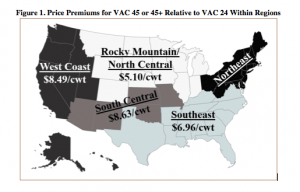by Maggie Smith, Graduate Research Assistant
The benefits associated with the incorporation of preconditioning practices are thoroughly understood. Increased management in the form of vaccinating and weaning have proven to reduce the risk of bovine respiratory disease, while increasing immunity and minimizing stress. While extensive research shows that preconditioning programs provide price premiums on a national basis, the effect of management level throughout different regions of the United States has not been examined. Differences in climate, management and marketing strategies, and variation in trucking distance are all regional factors that may influence the health protocol calves receive. With these concerns in mind, it is important to consider that the relative value of a vaccination or health program may be dependent on where the calf is raised.
Purpose
The purpose of this study was to investigate effects of value-added health protocols within various regions of the United States on the sale price of beef calf lots sold through summer video auction from 2010 through 2018.
Study Description
Information describing factors about lots marketed and sold through a livestock video auction service (Superior Livestock Auction, Fort Worth, TX) were obtained in an electronic format. There were 43,242 total lots of beef calves offered for sale within the study, spanning from 2010 through 2018. A lot was categorized into one of five groups according to vaccination and weaning management protocol: 1) VAC 34 or 34+ (vaccinated prior to shipping), 2) VAC 45 or 45+ (weaned 45 days, vaccinated 2 or 3 times), 3) Weaned: viral vaccinated, 4) Non-weaned: viral vaccinated, and 5) VAC 24 (vaccinated at 2 to 4 months of age). Calf lots originated from one of five U.S. regions: West Coast, Rocky Mountain/North Central, South Central, Southeast, and Northeast (excluded due to few lots). For each region included within the study, a separate multiple regression model was developed using a backwards selection procedure to evaluate the effect of health protocol on the sale price of beef calves. Price premiums for various health programs were compared to the VAC 24 program. The effect of varying levels of vaccination and weaning management were also examined on a national basis, which included all 4 previously indicated regions.
The specific and current requirements of each of the video auction’s recognized vaccination protocols (VAC 34 and 34+, VAC 45 and 45+, and VAC 24) are available at www.SuperiorLivestock.com. Calves not qualifying for a vaccination program were categorized into one of two groups: lots that were weaned and received at least one dose of a viral vaccination prior to shipment from the farm or ranch of origin (Weaned: viral vaccinated), and those lots that were non-weaned and received at least one dose of a viral vaccination (Non-weaned: viral vaccinated).
Results
Within the national analysis including all four regions, the greatest price premium ($7.09/cwt) was associated with lots qualifying for VAC 45 or 45+. Within the West Coast and Southeast regions, VAC 45 or 45+ and Weaned: viral vaccinated, both health categories that involve the management practice of weaning prior to shipment, held similar premiums in price ($8.49/cwt and $8.58/cwt in the West Coast, $6.96/cwt and $7.87/cwt in the Southeast), greater than all other health protocols in their respective regions. In both the North Central and South Central regions, lots meeting the requirements for VAC 45 or 45+ were associated with the greatest premiums in price within their respective regions ($5.10/cwt and $8.63/cwt, respectively). Overall, VAC 34, VAC 45 or 45+, and Weaned: viral vaccinated lots were associated with premiums across regions, relative to VAC 24.
While there are clear price advantages associated with intensive vaccination and weaning management strategies across all areas, the value of specific health protocols varies between individual regions. Referenced through Figure 1, using the health protocol of VAC 45 or 45+ as an example, findings indicate that as distance between origin of calves sold from the most concentrated area of cattle feeding in the northern plains became greater, price premiums relative to VAC 24 increased. Results suggest an increase in the value associated with vaccination programs for those areas located farther away from the plains, as calves transported longer distances may be at greater risk of health issues.
The Bottom Line
Information regarding the effect of vaccination and weaning management level on beef calves throughout various regions of the United States may prove valuable to producers with different management and marketing goals.
